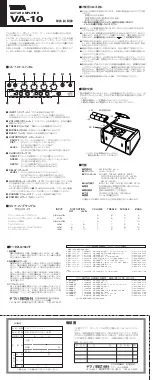
00040681.DOC, Version 1.1
26/28
6.4 Emergency power supply
For continuous operation of the amplifier in case of a possible mains failure, a 12 V rechargeable battery can
be connected to the terminals DC 12 V. In case of a mains failure the power switch is out of function. To
switch on the amplifier, use the emergency power switch DC SW.
7. OPERATION
7.1 Amplifier
1. Prior to switching on, turn the master control and the level controls of the microphone channels to zero to
avoid a possible switching-on noise. The switch on the unit with the power switch. The power indicator
lights up. In case of a possible mains failure switch on the ampilfier with the emergency power switch DC
SW.
2. Turn up the master control so that the mixing ration of the three channels MIC PRIORITY, MIC 2, and
AUX/MIC 3 can be adjusted in an optimum way.
3. With the input selector AUX/MIC 3 adjust the channel AUX/MIC 3 to the connected source:
• button pressed: input switched to microphone level
• button not pressed: input switched to line level
4. Adjust the desired volume ratio with the level controls of the channels MIC PRIORITY, MIC 2, and
AUX/MIC 3. In case of an announcement via the microphone channel MIC PRIORITY the level of the
other channels is drastically attenuated thereby increasing the intelligibility of the announcement. After
the announcement, the level of the other channels slowly returns to the original level.
5. Adjust the desired sound with the tone controls. By adjusting the tone controls, the high frequencies
(control TREBLE) and the low frequencies (control BASS) can be boosted or attenuated. With the
controls in mid-position, the frequency response is not affected.
6. Adjust the definite level of the total volume with the master control. The 5-step LED row shows the output
level. An optimum level control is obtained if level values up to 0 dB are shown at average volume. If the
red LED +3 of the LED level meter lights up, slightly turn back the master control.
7. The alarm siren can be switched on and off with the button SIREN:
• button pressed: siren on
• button not pressed: siren off
7.2 Tuner
Put the receiving antenna in a vertical position and switch on the tuner with the button . The device is in
tuner mode. The display shows the station number last selected and the corresponding received frequency.
7.2.1 Storing and calling stations
The tuner is able to receive FM and medium wave stations. The FM band is divided into three identical
subbands (F1, F2, F3) and the medium wave band into two (A1, A2). In each subband six stations can be
stored, i.e. a total of 18 FM and 6 medium wave stations.
1. Switch to the desired FM or medium wave band with the button BAND.
2. For station tuning, automatic or manual station finding can be used.
A. For automatic station finding use the buttons
and or the button SCAN:
• Button
or
: Pressing the buttons shortly will start the automatic station finding. The station finding
stops at the next station.
• Button SCAN: Pressing the button shortly will start the automatic station scanning. The scanning will be
running forward and stop at the next station for 5 seconds (the station's received frequency will be
flashing on the display). Afterwards the scanning will be running to the next station.
B. For manual fine tuning use the buttons
and
or the buttons and :
• Button
or
: The received frequency can be increased or reduced step by step with each actuation
of the buttons (in the FM band by 50 kHz, in the medium wave band by 9 kHz).
• Button or : Long actuation of the buttons activates the manual station finding (indication MANUAL).
Then the received frequency can be increased or reduced step by step with each actuation of the
buttons. After 5 seconds the tuner switches to automatic station finding again (indication AUTO).
3. To store a station, keep the desired station button 1 to 6 pressed until the station number appears on the
right side next to the received frequency.
4. To call a stored station, select the corresponding band with the button BAND and press the station
button of the station.
Содержание EIO3-50II
Страница 2: ......



































